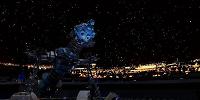
Beyond the Atmosphere: Inside the Adler Planetarium
Chicago, Illinois, USA
Saturday, March 24th, 2007 • 8:30am Local (CDT) • 1330 UCT
At night, however, the sky grows dark and our vista expands beyond mere miles. When the stars come out, we can see across the span of countless trillions of miles and millions of years into the past.
Sadly, for those of us who live in or near cities, the sky is rarely dark at night. Dust, smoke, soot and other pollutants, streetlights, billboards, homes and businesses aglow fill the night sky with a different light, a man-made one. The urban view of the night sky is a pale comparison to the one afforded those lucky enough to live where the sky is truly clear at night.
What if we could make the atmosphere disappear? Temporarily of course! Or at least turn off all the lights and magically eliminate all the dust and pollution? We can’t really do either, here in Chicago, but in the Adler Planetarium we can simulate it. Using a sophisticated projector, the night sky is recreated on the surface of a hemispherical dome. We can relax in comfortable reclining chairs, soak up the “atmosphere”, as it were, and view the sky as it would appear from any place, and from any time, on Earth.
The Adler Planetarium recently celebrated its 75th anniversary and is the oldest Planetarium in the United States. In addition to the historic Zeiss Planetarium Theater captured in this panorama, the Adler houses a wonderful museum, featuring a world class collection of antique astronomical instruments and the world’s first all digital projection theater. The Planetarium is also a leader in science education with programs for astronomy enthusiasts of all ages. For additional information visit: http://adlerplanetarium.org
On a more technical note, the image you see is not real in the sense that in order to get a “dark, starry sky” above and a view of the theater and the controls below, a composite of two different exposures was used to create this panorama. The glow at the top of the image is the result of having lights shining up on the projector during the procedure. This was purposefully done to highlight the dome itself. In the normal course of a sky show, the theater is in almost complete darkness.
The sky projected on the dome accurately represents the position of the stars near the time the image was created. North is behind the control panel, the city is to the west and darkness over Lake Michigan is to the east. Taurus is clearly visible rising in the east, Ursa Major (the Big Dipper) is setting behind the buildings of the city. Andromeda is high overhead; look for the Andromeda galaxy just outside the lighted part of the dome. Other constellations are there if you look for them. The sun and moon were not projected.
Many thanks go out to the staff of the Adler Planetarium, especially Mark Webb, the Theaters Manager, for allowing me the opportunity to come in and create this image.



 Tap or click the zoom icon in the bottom right corner of the picture to switch between in-page and fullscreen view
Tap or click the zoom icon in the bottom right corner of the picture to switch between in-page and fullscreen view